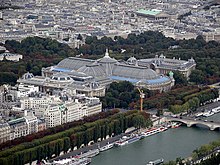Champs-Élysées - Clemenceau (Métro Paris)
|
|
|
|---|---|

|
|
| Tariff zone | 1 |
| Line (s) |
|
| place | Paris VIII |
| opening | July 19, 1900 |
Champs Élysées - Clemenceau is an underground transfer station for lines 1 and 13 of the Paris Métro .
location
The metro station is located in the Quartier des Champs-Elysees of the 8th arrondissement of Paris . The station of line 1 is located lengthways under the Avenue des Champs-Élysées at the level of Place Clemenceau , the line 13 under the Jardins des Champs-Élysées northeast of the Grand Palais .
Surname
It is named after the Avenue des Champs-Élysées. Its name is derived from the "island of the blessed" Elysion , the place of residence of virtuous souls in Greek mythology .
On May 20, 1931, the subway station was given the suffix "Clemenceau", which indicates its location on the 1,910 m long Avenue des Champs-Élysées. Place Clemenceau is named after Georges Clemenceau (1841–1929). The journalist , politician and statesman of the Third Republic was French Prime Minister from 1906 to 1909 and 1917 to 1920.
history
The station went into operation on July 19, 1900 with the opening of Line 1, which at that time ran on the section from Porte de Vincennes to Porte Maillot . At the beginning of the 1960s, the station on Line 1 was extended from 75 m to 90 m and converted for traffic with rubber-tired trains . In April 2009, as part of the introduction of driverless operation, their platforms were raised, and since mid-2009 they have had platform screen doors .
On February 18, 1975, the station on line 13, which was extended by one station from Miromesnil , opened. Until November 9, 1976, Champs Élysées - Clemenceau was temporarily the southern terminus of the line.
description
In contrast to the construction method with elliptical cross-section, which is more common in Paris , the station on Line 1, which is built in an open excavation, has a horizontal metal ceiling. Longitudinal girders, which carry small vaults made of bricks, rest on iron support beams that are perpendicular to the direction of travel.
The station on line 13 has a rectangular cross-section under a concrete ceiling, it is 75 m long. To the north of its station, line 13 passes under the tunnel of line 1, and there is no track connection between the two lines. Line 13 has an easy track change south of its station .
The only exit (with escalator) leads to Place Clemenceau. The modernized stone parapet is adorned by a candelabra designed by Adolphe Dervaux in the Art Deco style .
vehicles
Initially, trains ran on Line 1, which consisted of a railcar with only one driver's cab and two sidecars . These vehicles were two-axle and each nearly nine meters long. As early as 1902, eight-car trains were formed, each with a railcar at the ends of the train. The railcars were replaced by four-axle vehicles on bogies until 1905, and the sidecars from 1906 . In 1908, green painted five-car trains of the Sprague-Thomson design entered Line 1, which stayed there until the 1960s. From May 1963, the Sprague-Thomson trains, which ran on rails, were successively replaced by the MP 59 series with rubber-tyred vehicles , until December 1964 there was mixed traffic of the two modes of operation. The MP 89 CC series followed in 1997, which gave way to the MP 05 series with the start of automatic operation .
The MA series operated at the station of Line 13 until 1976 , and from 1975 onwards - and exclusively from 1976 - the MF 67 series . In 1978, the line was the first to receive the new MF 77 series trains , which has been the only vehicle type that has operated there since then.
Surroundings
- Élysée Palace , official seat of the President of the French Republic
- Grand Palais , an exhibition building built for the World's Fair in 1900
- Petit Palais , municipal museum of fine arts (Musée des Beaux-Arts de la Ville de Paris)
- Théâtre Marigny
Remarks
- ↑ Before the two lines were connected on November 9, 1976, the spatially separated section south of the Seine was numbered 14
- ^ After the metro accident at Couronnes station in August 1903, both railcars ran one behind the other at the Zugspitze
- ↑ In contrast to usual, the trains on Line 1 were kept in light gray from the early 1930s onwards (with the 1st class car that was still red)
- ↑ CC means "Conduite Conducteur" (driver-controlled), in contrast to the driverless type MP 89 CA
Web links
literature
- Gérard Roland: Stations de métro. D'Abbesses à Wagram . 2003, ISBN 2-86253-307-6 .
Individual evidence
- ^ Gérard Roland: Stations de métro d'Abbesses à Wagram . Christine Bonneton, Clermont-Ferrand 2011, ISBN 978-2-86253-382-7 , pp. 74 .
- ^ Jean Tricoire: Un siècle de métro en 14 lignes. De Bienvenüe à Météor . 2nd Edition. La Vie du Rail, Paris 2000, ISBN 2-902808-87-9 , p. 130 f .
- ^ A b c Brian Hardy: Paris Metro Handbook . 3. Edition. Capital Transport Publishing, Harrow Weald 1999, ISBN 1-85414-212-7 , pp. 36 .
- ↑ Jean Tricoire: op. Cit. P. 134.
- ↑ Jean Tricoire: op. Cit. P. 132 ff.
- ↑ Jean Tricoire, op. Cit. P. 307.
- ↑ Jean Tricoire, op. Cit. P. 311.
| Previous station | Paris metro | Next station |
|---|---|---|
|
Franklin D. Roosevelt ← La Defense |
|
Concorde Château de Vincennes → |
|
Miromesnil ← Saint-Denis - Université or Asnières - Gennevilliers - Les Courtilles |
|
Invalides Châtillon - Montrouge → |
Coordinates: 48 ° 52 ′ 4 " N , 2 ° 18 ′ 50" E



